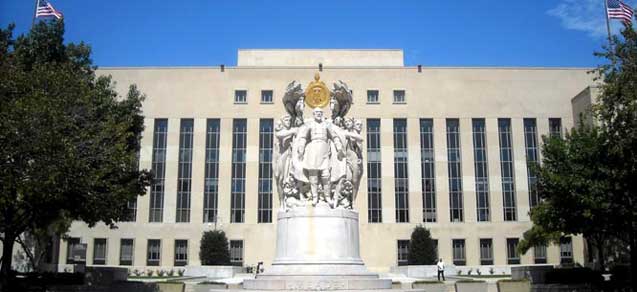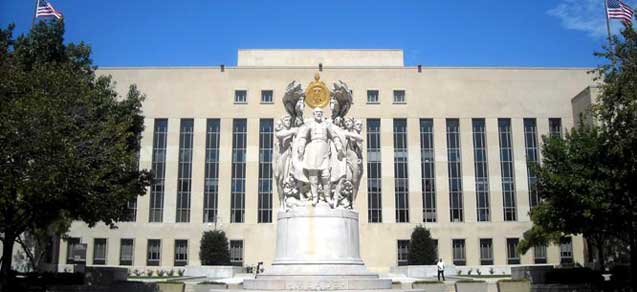
 E. Barrett Prettyman Federal Courthouse, home of the D.C. Circuit Court. (Photo: 2008, Wikimedia Commons)
E. Barrett Prettyman Federal Courthouse, home of the D.C. Circuit Court. (Photo: 2008, Wikimedia Commons)
While journalists and academics pay much attention to the Supreme Court and “the Nine,” the D.C. Circuit Court of Appeals, considered by some to be the second most important U.S. court, often goes ignored. The D.C. Circuit is the training ground for the Supreme Court and the place where much of the nation’s regulatory framework is decided. In its current form, it is one the most dangerous courts in the land.
Much has been written recently about the four vacant seats (out of eleven) on the D.C. Circuit and the Republican filibuster on all of Obama’s nominations to the court. However, most writers have followed Obama’s lead in treating the vacancies as creating a problem of “timely access to justice,” Democrats have become so accustomed to Republican efforts to weaken legislation or federal agencies through the filibuster of key personnel that they are unable to notice when something different is happening. As the D.C. Circuit’s current constitution and body of decisions show, Republicans have effectively transformed the court, which now provides a second shot for Republicans to overturn and amend legislation and regulations, into an alternate route to defeat government regulations. What we’re witnessing is a spectacular power grab by conservative legislators, a twenty-first-century version of Marbury v. Madison in slow motion.
Some have argued that the D.C. Circuit’s character is different as a matter of historical accident—lawyers simply treat it as the proper venue for challenging (or supporting) executive power. But there are important structural qualities that distinguish it from other federal courts. For one, it is among the most politicized of the already-partisan federal courts; the D.C. Circuit is often regarded as a stepping stone for the Supreme Court, with four of the nine current justices having served there. Yet the D.C. Circuit is not just a springboard to the big leagues. It is also accorded a special privilege that other circuits are not: it has jurisdiction over any case involving a federal agency. This means that if a company is fined by the EPA in San Francisco, for example, it can choose to appeal its case in California or with the D.C. Circuit. In the term ending in 2012,40 percent of the D.C. Circuit’s cases involved a federal agency, compared to less than 14 percent for the remaining circuits. As a result, the D.C. Circuit has a disproportionate influence on federal regulatory power. Whether a regulation concerns banking institutions (through the Securities and Exchange Commission), labor relations (through the National Labor Relations Board), power and utility companies (through the Department of Energy), the D.C. Circuit has a hand in shaping it. This undeniable fact should cause concern for anyone who still be believes in a traditional separation of powers.
On its face, the D.C. Circuit, which hears cases in three-judge panels, appears roughly split between four Republicans and three Democrats, with four vacancies. However, this simple count ignores a key feature of the federal judiciary: senior judgeships. Many judges do not retire, but instead choose senior status, which makes their seat officially vacant but places them on part-time work.
On the D.C. Circuit, there are six senior judges, which is almost the number of active judges, with five having been appointed by Republicans. In all the cases decided in 2013, almost 70 percent of the three-judge panels included at least one senior judge. As a result, almost 80 percent of the panels in 2013 were composed of exclusively or a majority of Republicans.
The results of this partisan court are not surprising. Many of the D.C. Circuit’s recent decisions have skewed heavily to the right, evincing the sort of judicial activism that Republicans claim to despise. In two high-profile cases involving the NLRB, the court went much further than it needed in showing its support for management over workers and, in the process, invited challenges to crucial features of federal regulation. In Noel Canning v. NLRB, the court held that Obama’s recess appointments to the NLRB and the Consumer Finance Protection Bureau were unconstitutional, placing the validity of hundreds of recess appointments over decades in jeopardy. Then, in the National Association of Manufacturers v. NLRB, the court held the NLRB’s new rule requiring employers to post employee labor rights violated employers’ First Amendment rights—the federal government can’t “force” employers to tell employees about their rights. The logic of this decision was so broad that it jeopardizes hundreds other federal and state health, safety, and employment notifications currently required of employers, like the minimum wage and OSHA posters that nearly every employee in the United States sees in his or her break room.
The court’s conservative attacks on regulations have not been limited to the labor and employment context. In August of 2011, the court issued a decision striking down new EPA rules on air pollution that crosses state lines. In a scathing dissent, the sole Democrat on the panel wrote that the majority’s opinion was
an unsettling of the consistent precedent of this court strictly enforcing jurisdictional limits, a redesign of Congress’s vision of cooperative federalism between the States and the federal government in implementing the [Clean Air Act] based on the court’s own notions of absurdity and logic that are unsupported by a factual record, and a trampling on this court’s precedent on which the Environmental Protection Agency (“EPA”) was entitled to rely in developing the Transport Rule rather than be blindsided by arguments raised for the first time in this court.
Similarly, the court severely hindered the SEC’s ability to issue new rules as was intended under the Dodd-Frank Act. In Business Roundtable v. SEC, the D.C. Circuit struck down a new SEC rule that would require corporations to reveal more information to shareholders concerning board nominees. In an article for the Texas Law Review, James Cox and Benjamin Baucom argued that the D.C. Circuit defied the Supreme Court and Congress and effectively usurped the role of the SEC.
Because of the large numbers of appeals to the Supreme Court (approximately 10,000) and the small docket it keeps (approximately eighty case each year), most cases will not be accepted for appeal to the Supreme Court regardless of their merits. In the 2012 term, the D.C. Circuit decided almost 1,200 cases, and three were accepted for appeal at the U.S. Supreme Court. For the vast majority of these cases, the D.C. Circuit will serve as the final word. And this final word is often a highly conservative and activist take on important regulations.
Republicans are fully aware of the power they hold with the D.C. Circuit, which is why they are unwilling to confirm Obama’s appointments. If they did, they might weaken their backdoor challenge to federal regulations. With the court’s high vacancy rate and a deep back-bench of conservative senior judges, the Republicans have no reason to budge on this matter. The filibuster of D.C. Circuit nominees is of a decidedly different quality than other filibusters; it has created a space where ultra-conservative Reagan appointees in semi-retirement still have sway over the nation’s policies. Reagan’s ghost now appears in the judiciary, while his descendants cry out against “liberal judicial activism.” Such sleight-of-hand politics may not be surprising, but they should still be alarming: the D.C. Circuit is threatening the regulatory efforts of the federal government in a way that helps few and hurts many.
Join us in defending the truth before it’s too late
The future of independent journalism is uncertain, and the consequences of losing it are too grave to ignore. To ensure Truthout remains safe, strong, and free, we need to raise $46,000 in the next 7 days. Every dollar raised goes directly toward the costs of producing news you can trust.
Please give what you can — because by supporting us with a tax-deductible donation, you’re not just preserving a source of news, you’re helping to safeguard what’s left of our democracy.